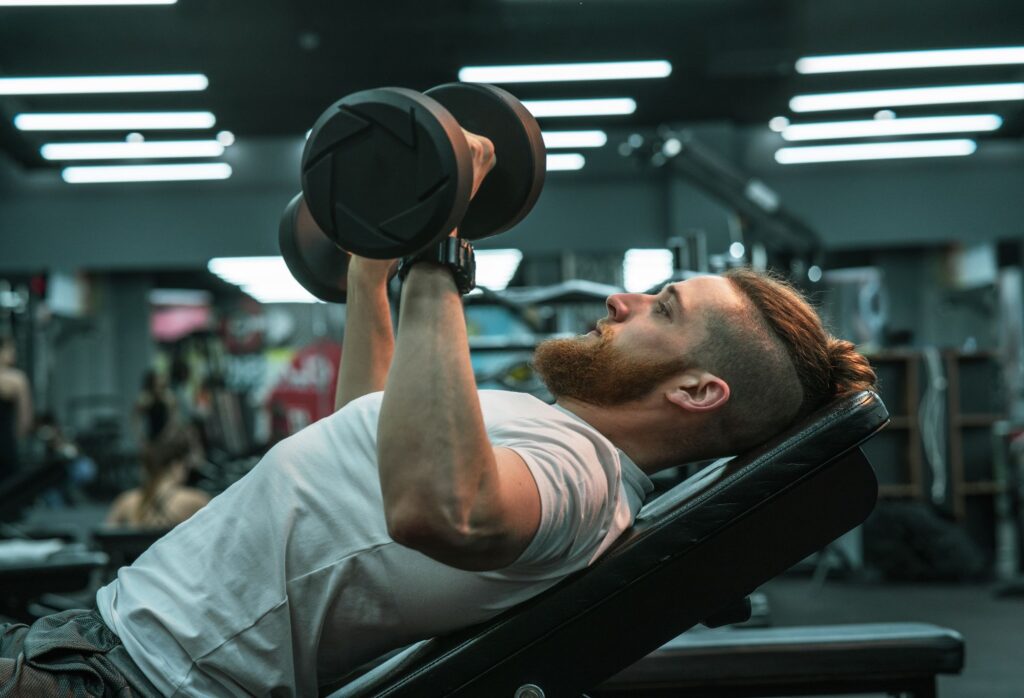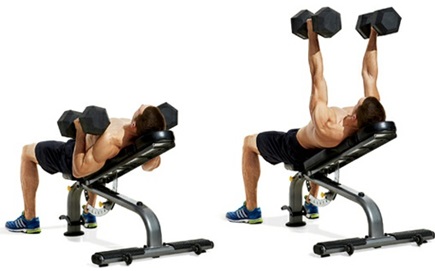The incline dumbbell press is a staple exercise that targets the upper chest muscles primarily while also activates front deltoids, and triceps secondarily. By performing this movement on an incline bench, you can isolate the upper chest and achieve a greater range of motion than most other upper chest exercises, leading to increased muscle activation and growth. In this comprehensive guide, we’ll walk you through the proper technique, benefits, variations, and common mistakes of the incline dumbbell press to help you maximize your results and minimize the risk of injury so that you can safely get a defined and visible upper chest with or without clothes. Without further wasting time, let’s jump into the topic.

Understanding the Incline Dumbbell Press
This popular chest building movement is a compound exercise that involves pressing dumbbells upwards while lying on an incline bench set at an angle of approximately 30 to 45 degrees. This angle targets the upper chest muscles (pectoralis major) primarily, anterior deltoids (front shoulder muscles), and triceps secondarily. Although it’s considered a compound movement, it’s great for isolating the upper chest. The incline dumbbell press can be performed by individuals of all fitness levels, from beginners to advanced lifters.
Also Read: Incline Push Up: How to, Variations, Tips & Benefits!
Benefits of the Incline Dumbbell Press
Upper Chest Development
The incline angle of the bench places greater emphasis on the upper chest muscles, helping to develop size, strength, and definition in this area. In fact, it’s one of the most popular and greatest upper chest exercises that almost every gym-goer does.
Shoulder Engagement
The incline dumbbell press also engages the anterior deltoids, helping to improve shoulder stability and pushing strength because almost every pushing movement needs the engagement of front deltoids and this exercise helps to strengthen this portion of your deltoids along with upper chest.
Range of Motion
Performing the dumbbell press on an incline bench allows for a greater range of motion compared to other pressing movements for chest, leading to increased muscle activation and growth.
Muscle Symmetry
The unilateral nature of the dumbbell press allows for balanced development of the chest muscles, helping to address any muscle imbalances between the left and right sides of the body. In a nutshell, it is more flexible than any other pressing movements with barbells namely barbell bench press.
Stability and Control
Using dumbbells for the incline press requires greater stabilization and control compared to a barbell, leading to improved balance and coordination.
How to Perform the Incline Dumbbell Press
Setup
Adjust the bench to a 30 to 45-degree angle inclined position. Sit down on the bench and position yourself so that your back is firmly against the bench and your feet are flat on the floor. Hold a dumbbell in each hand with an overhand grip which means your palms should be facing forward.
Starting Position
Lift the dumbbells to shoulder height, with your elbows bent and pointing outwards. Your wrists should be straight, and your shoulders should be relaxed.
Execution
Exhale as you press the dumbbells upwards, extending your arms fully until they are almost straight but without locking your elbows. Keep your wrists stable and maintain control as well as balance throughout the movement.

Peak Contraction
At the top of the movement, your arms should be fully extended, and your chest should be lifted. Hold this position for a brief moment like one to two seconds to maximize muscle engagement in the upper chest.
Lowering Phase
Inhale as you slowly lower the dumbbells back down to shoulder level, allowing your elbows to bend and your shoulders to rotate naturally. Keep the movement controlled and resist the urge to let the weights drop.
Full Range of Motion
Lower the weights until your elbows are at approximately 90 degrees or slightly lower, allowing for a full stretch in the chest muscles. Avoid bouncing or jerking the weights at the bottom of the movement.
Repeat
Complete the desired number of repetitions with proper form and technique. Aim for 8-12 repetitions per set, adjusting the weight as needed to challenge your muscles while maintaining good form.
Cooldown
Once you’ve completed your sets, carefully lower the dumbbells back to the starting position and take a moment to stretch your chest and upper body to promote recovery and flexibility.
How to Include the Incline Dumbbell Press into Your Routine
The incline dumbbell press can be incorporated into your chest training routine to target the upper chest muscles and improve overall upper body strength. Aim to include this amazing exercise as part of a comprehensive workout program that targets all major muscle groups of the upper body, including the chest, back, shoulders, and arms. For best results, you should include it in your push day or chest day alone.
Perform the incline dumbbell press 2 times per week, with 3-4 sets of 8-12 repetitions per session. Start with a light weight to warm up the muscles and gradually increase the weight as you become more comfortable with the movement.
In addition to this upper chest exercise, include a variety of other effective chest exercises such as flat bench press, decline bench press, and flyes to target different areas of the pectoral and ensure balanced muscle development throughout the whole chest so that it looks perfectly defined and attractive.
Common Mistakes to Avoid
Arching the Back
Avoid arching your lower back excessively during the incline dumbbell press. Maintain a neutral spine to prevent strain on the lower back and maintain proper alignment.

Using Momentum
Don’t use momentum to lift the dumbbells, as this reduces the effectiveness of the exercise and increases the risk of injury. Focus on using controlled, deliberate movements to maximize muscle engagement.
Incomplete Range of Motion
Ensure that you fully extend your arms at the top of the movement and lower the weights until your elbows are at approximately 90 degrees or slightly lower to maximize muscle activation and growth with the help of full range of motion.
Gripping the Weights Too Tightly
Avoid gripping the dumbbells too tightly, as this can lead to tension in the forearms and wrists. Instead, maintain a firm but comfortable grip on the weights throughout the exercise.
Lifting Excessive Weight
Choose a weight that allows you to perform the exercise with proper form and technique. Using excessively heavy weights can compromise your form and increase the risk of injury on your chest and shoulders.
Variations of the Incline Dumbbell Press
Alternating Incline Dumbbell Press
Perform the exercise with one arm at a time, alternating between the left and right arms. This variation helps to address muscle imbalances and improve stability and coordination.
Neutral Grip Incline Dumbbell Press
Hold the dumbbells with a neutral grip (palms facing each other) instead of an overhand grip. This variation places less stress on the wrists and may be more comfortable for some individuals. You can also hold the dumbbells together while using a neutral grip and perform the movement. Close grip will allow you to focus more on inner chest muscles.

Supinated Grip Incline Dumbbell Press
Perform the exercise with a supinated grip (palms facing upwards) to target the biceps and inner chest muscles to a greater extent.
Also Read: Incline Dumbbell Curl: How-to, Pro Tips, Variations & More!
Conclusion
The incline dumbbell press is undoubtedly one of the most effective exercises for targeting and building the upper chest muscles. By mastering proper technique, avoiding common mistakes, and incorporating variations into your routine, you can maximize the benefits of this exercise and achieve your fitness goals safely and effectively. Whether you’re a beginner or an experienced lifter, the incline dumbbell press offers a valuable addition to your chest training arsenal for building size, strength, and definition in the upper chest and improving overall upper body pushing strength. Hopefully, you found this article helpful enough. If you really did then let us know your valuable unfiltered thoughts in the comment section below. Thanks for visiting and appreciating our work.
